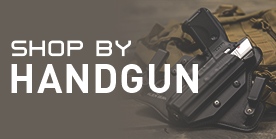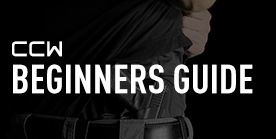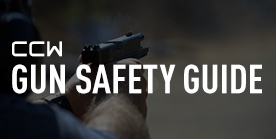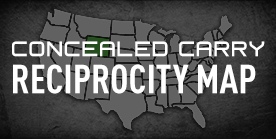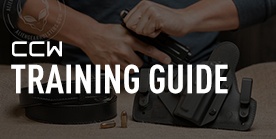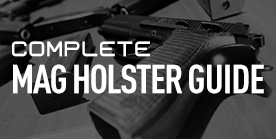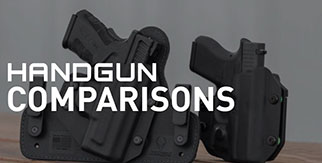How To Use A Paddle Holster
While a paddle holster is a great choice for a carry holster, it is merely a tool like any other holster. If you want to get the best from one, and benefit from having it, it's a good idea to know a bit about them.
In other words, if you know how a tool is best used, you'll know how it benefits you.
A paddle holster, in and of itself, is a type of outside the waistband (OWB) holster, meaning it's worn on the belt and outside of the pants. It can be used for concealed carry or open carry. Some work well for both, and some are more for open carry only.
What, though, is that intended purpose?
What Is A Paddle Holster Used For?

What is a paddle holster used for?
The classic use for a paddle holster is for when you want or need to take your gun on and off more frequently. The classic example is a police detective or lawyer who has to take their gun off to go into the courthouse, or the office worker taking their gun off to sit at their desk.
The idea is that you can put the holster on when you're out and about, but can take it off when you need to.
Some people also keep them as range holsters, meaning that they wear a paddle holster when they're at the shooting range but don't elsewhere, so it's kept for training or competition purposes.
Those instances are, again, the archetypical uses for a paddle holster. You can use it when you need it, but you can also take it off for when you don't.
Design of paddle holsters reflects the intended use. Some are made to ride high and tight, easily concealed under a jacket or other cover garment and therefore for concealed carry.
Others are clearly intended more for open carry as ride height is too low or the holster sticks out too far to easily be concealed. Those holsters are really more for competition or range use, as a bit of clearance between the hip and the pistol makes for an easier draw.
While usable for daily carry, many people use paddle holsters in more of a supplementary role. You can stick one in your range bag for competition or range day, or you only wear it when you know you'll be taking the gun on and off, but wear a different holster the rest of the time.
If you were going to get, say, two holsters for a new pistol, having a concealed carry holster - like a good IWB or high-and-tight OWB - along with a paddle holster for occasional use would be a great two holster combo.
The Achilles' Heel Of Paddle Holsters Is The Paddle Attachment

If there's a weakness to paddle holsters, it's the paddle attachment itself. Some are good and some...well, not so much.
If you're considering getting a paddle holster, that's the aspect of the holster you have to pay attention to in order to equip yourself with a holster that's going to function as it should.
Regardless of what kind of holster you're carrying, there are certain things that you just can't compromise on. A solid connection to the body - and in the case of waistband holsters, it's to the waistband and/or belt - is an absolute must.
This is classically been the failing of paddle holsters and by this point is a known quantity. Poor quality examples are known for either working their way out of the waistband, and in the case of polymer paddle attachments, the paddle can even be broken off by an assailant.
Another known failing is how well the paddle anchors to the body or to the belt. A smooth paddle won't grab the waistband or belt tight enough and will come out with the pistol on the draw.
Therefore, you have to take pains to select a paddle holster that makes a solid connection to the waistband and/or the belt. Without that critical aspect, everything else about the holster is meaningless.
What To Look At If You're Thinking Of Getting A Paddle Holster

Since the paddle is arguably the most important part of a paddle holster - not that the holster itself isn't important; we'll get to that shortly - is the paddle attachment itself, there are a few things that you should look for in one.
The paddle should be wide, taking up a good amount of real estate so that it grips as much surface area as possible.
The connection to the holster itself should be solid, rigid even. It should be almost impossible for the holster to be broken off from the paddle with the bare hands.
The paddle itself should have a feature for grabbing onto clothing or for hooking underneath a belt, such as a retention lip. If inserted over the waistband, this will help the paddle grab onto the fabric. If worn on the belt, it turns a paddle holster into an ersatz belt slide.
The holster itself should be made for the pistol you'll carry. It should have passive retention - ideally adjustable - and should allow for a smooth draw and easy reholstering. This won't happen with cloth holsters and leather holsters of poor manufacture.
Again, the idea behind a paddle holster is a holster that can be taken off the body and put back on when desired; it's a tool of convenience. The inherent compromise, of course, is that it's less durable, less functional, than a standard belt holster.
Unless, of course, you purchase a quality paddle holster to begin with.
How To Wear A Paddle Holster

The two ways to wear a paddle holster are to press the paddle over the waistband of the pants or to slide the paddle behind the belt.
Which is the best way to wear it?
That depends on how you define "best." One will be better for you.
Putting the paddle over the waistband puts the paddle between the waistband and your flesh, which means you'll get intimately acquainted with it's texture and shape. You may or may not find a spot on the body where it's comfortable to carry.
On the belt is going to be more comfortable, but will slightly lower the ride height, which will make the holster a little harder to conceal unless you're carrying a micro or compact pistol.
Another difference is how the holster rides when you carry it.
If attached to the waistband, a paddle holster is going to jostle a little bit more than a more typical OWB such as a belt slide. It's just going to happen; there's basically nothing to do about it.
If secured by the belt, however, this effect is mitigated.
If concealability is important above all else and you're just going from the car to the office, the waistband is going to be the better use. If you're wearing the holster for extended periods of time, attaching the holster to the belt is the best practice.
Paddle Holsters: Best Of Both Worlds Or Designated Hitter?

When it comes to paddle holsters, it's up to you to determine how you want to use them. For some people, it's the best type of holster for daily carry and for others they're better used akin to a designated hitter in baseball.
For those unfamiliar, a designated hitter is a baseball player who only bats; they don't play infield or outfield at all. Previoulsy it was only done in the American League conference of MLB until the 2020, when the National League decided to join the AL in committing heresy.
For some people, a paddle holster is the DH in their lineup.
On days when they know they'll be taking the gun on and off, or if they're only using the holster for a limited period of time, they use the paddle holster and then revert to a more typical IWB or OWB.
Granted, many IWB holsters are pretty easy to take on and off. In terms of the effort that has to be expended and time taken, they're basically equal to that required to take a paddle holster on or off, if not actually easier in some cases.
Then again, there are other people for whom a paddle holster actually makes a lot of sense for EDC.
Let's say a person has an office job. The gun is concealed walking from the car to the office, but once they get inside, they want to take the gun and their coat off. The holster and gun go in a drawer or a holster mount under the desk, and they go about their day.
If you're only going from the parking lot to the office it's a perfectly viable system, and for just such a person, a paddle holster makes a lot of sense. You switch to an IWB when out and about otherwise, but during the work week, it's a convenient way to carry.
Granted, make sure that the gun is in a secure location and concealed from view. If stashing it in a desk drawer, lock the drawer.
If you were considering getting a paddle holster, either for EDC or for range use, consider what your lifestyle is and how the holster would fit into it.




